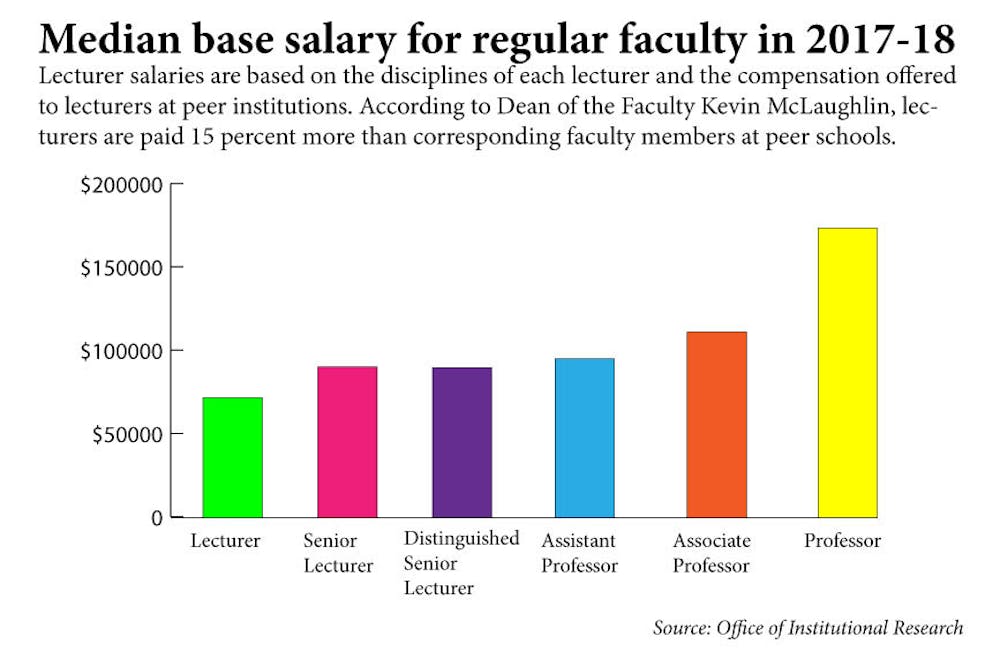Before Jacinda Townsend, assistant professor of literary arts, came to Brown, she had already amassed many titles: journalist, lawyer, novelist and public school board president.


She initially wanted to be a politician, studying Government at Harvard and then attending Duke Law School. Following graduating, she became a broadcast journalist.
After, she worked as an antitrust lawyer in New York City. But, while in law school, she took English classes that inspired her to pursue writing.
Townsend then left to pursue her MFA from the Iowa’s Writers Workshop and become a Fulbright scholar in Côte d’Ivoire. She published novels and taught at several universities in the Midwest and California before leaving academia for a few years.
On her journey, she ended up on the Board of Education for Ann Arbor, which she described as a full-circle moment to her early political aspirations.
Eventually, she joined Brown’s faculty in the MFA program.
“I came running back” to academia, Townsend recalled. “I missed that electrifying feeling of being with students who are making art.”
Townsend’s path to professorship is just one of the many unique stories of faculty members at Brown.
The Herald analyzed data about 1095 faculty in undergraduate-focused departments and spoke to faculty to make note of some of the most common and uncommon paths taken to a faculty appointment.

A faculty appointment is often perceived as the epitome of an academic career. But it’s an achievement at the end of a long, complex road of training.
The traditional route to such an appointment is as follows: Aspiring faculty members obtain their bachelor's, master's and doctorate degrees, often work as a postgraduate researcher and eventually — if they’re lucky — get hired at the University.
But, the reality is that the “standard path” to becoming a faculty member can vary wildly, especially depending on the individual’s chosen field of study.
To visualize these journeys, The Herald followed faculty through stepping stones including their bachelor's, master’s, doctorate degrees and post-degree jobs, finishing when faculty were hired into academia.
The Sankey diagram displays the different paths to becoming faculty, with unique paths highlighted with different colors. Thicker paths represent a larger quantity of faculty that followed that path, and paths that contain less than 10 faculty are styled in light gray.
At the bachelor’s stage, The Herald broke down the universities faculty members attended into three categories — Top 20 U.S. universities, non-Top 20 U.S. universities and foreign universities — based on rankings from U.S. News. Faculty who did not have publicly available undergraduate data are marked as “Unknown.”
Few faculty attended a Top 20 university for undergraduate and a non-Top 20 University for their master's. Even fewer faculty went to a Top 20 school for their undergraduate and a school outside of the US for their master's.
The most common path to academia was attending a non-Top 20 university for all three degrees, embarking on research, and then being hired as faculty. The second most common was attending a Top 20 university for all three degrees, then getting hired as faculty directly out of their doctoral program.
The Herald found that the majority of faculty obtained a master’s degree, but less than 1% of faculty chose to obtain a whopping three master’s degrees. Roughly a third of faculty obtained no masters at all.
A small percentage of faculty not indicated in the diagram chose to pursue other professional degrees, such as law, medicine or business.
A small portion of faculty received degrees from universities outside the US before being hired at Brown. Across bachelor’s, master’s and doctoral degrees, faculty received degrees from 48 different countries across the world.
The Herald found that over 60% of faculty who received foreign bachelors later completed PhD programs in the United States.
The Herald also found that many faculty spent time between their doctoral degree and academia pursuing a variety of endeavors, ranging from education administration to the military.
The time it takes faculty to be hired at Brown varies greatly. On average, faculty took 2.34 years to get their first academic position and spent 5.34 years working in academia before joining Brown. For around 46% of faculty, being hired at Brown served as the first academic position of their careers.
The Herald also analyzed the data to measure the impact the type of school faculty attended for their doctorate had on how long it took to be hired.
Within the ten departments with the highest faculty count, Brown is more often the first academic position for hired faculty in departments like physics and computer science. In contrast, it takes a member of the history department an average of 7.17 years to get to Brown.
Across the four major classifications of departments, it takes faculty from the humanities on average 2.8 years longer than the physical sciences to get to Brown.
Assistant Professor of Modern Culture and Media Jinying Li attributes this difference to the lack of positions and funding in the humanities compared to STEM fields.
“There’s simply more positions in STEM,” Li said. “A lot of people are competing for a smaller percentage of opportunities, so of course people need to take a longer time.”
The Herald investigated rankings of schools that faculty attended for their undergraduate degrees.
Over a third of faculty at Brown who received bachelor’s degrees in the U.S. attended a Top 20 school as ranked by US News. In comparison, Top 20 schools conferred only 2.3% of total bachelor’s degrees received in the U.S. in 2022.
The Herald also looked at rankings of schools that faculty attended for their doctorate degrees.
Slightly over 50% of the faculty at Brown attended Top 20 schools in the U.S. for their doctorate. The other half of Brown faculty attended 201 schools globally.


The Academic Process
Most faculty lay a foundation for their academic careers in graduate school, according to Thomas Roberts, senior assistant dean for the Program in Medicine and professor in the department of ecology, evolution, and organismal biology.
“For someone to be successful in a search process at Brown, they have to have had some significant success in their research as a grad student and a postdoc,” Roberts told The Herald.
The search process in academia is notoriously competitive. According to Roberts, positions advertised in the biology department often get around 200 competitive applicants, of whom around 5 are interviewed and only 1 is selected for hire at Brown.
Once the journey begins in graduate school, hopeful academics often start to build “a record of important publications, (procure) funding, or (focus on) other accomplishments, like contributions to diversity, equity, and inclusion,” Roberts said.
Most departments at Brown are relatively small, according to Roberts, and hiring doesn’t happen often. The process is long because faculty “are hiring someone who they hope will get tenure, and be here for dozens of years,” said Roberts.
“You want to find someone who is going to be a colleague whom you interact with, may collaborate with, and teach alongside,” he said. “You want to get somebody who is going to be really successful, prominent, and a great teacher.”
Faculty Searches
At Brown, after a department requests a new faculty position to their relevant dean, the search process begins, according to the Handbook of Academic Administration. The Dean then evaluates and prioritizes these requests before posting job advertisements, which are reviewed by the Office of Institutional Equity and Diversity.
“It’s automatically posted in a bunch of areas such as on Brown’s website, but also (places) like the Journal of Higher Education,” Jim Russell, senior associate dean of the faculty and professor of earth, environmental and planetary sciences, told The Herald.
“The goal is to try to make the search as broadly advertised as we possibly can through recruiting the strongest and most diverse applicant pool we can,” he added.
Applications often include a candidate’s curriculum vitae, cover letter and a written statement detailing their research and teaching goals in addition to a diversity, equity and inclusion statement.
Each department sets up a search committee, which is composed of faculty and a diversity representative. The diversity representative “serves as an advocate for best practices as well as a resource to their colleagues on the committee,” according to the handbook.
The committee creates a shortlist of potential candidates who are invited for on-campus interviews. While interview procedures vary by department, candidates often give a research presentation in addition to meeting faculty, students and staff in the department.
The department recommends its top candidate to its dean, explaining the reasoning behind the decision. The search process is then reviewed by the OIED.
After an offer is made, potential faculty may negotiate for better salaries or benefits, including “startups” or funding to start research.
About 10% of faculty are identified via targeted opportunities or invited to apply to Brown, according to Russell. The candidates bring “truly outstanding qualities to the department and to the university,” according to the Handbook. Following the invitation, candidates undergo interviews as normal.
Candidates who went to Brown do not receive preference in the hiring process, Russell said: “We try to make sure that that is not a rationale for interviewing a certain person or not.”
But a large number of School of Public Health faculty completed training at Brown.
“We had a pipeline of faculty who … did a postdoc training at Brown, particularly because Brown has a nationally recognized clinical psychology postdoctoral consortium,” said David Williams, associate dean of faculty affairs at SPH and professor of behavioral and social sciences. “So we’ve had a lot of people come in through that process.”
This helped the department of behavioral and social sciences grow during its early years, Williams added, noting it has moved “completely away” from this practice, opting for national searches to recruit new faculty.
Competition in the search process
According to Roberts, any competitive edge in the search process is exploited to try to recruit the best candidates in academia. Factors like allotted lab space for the candidate, opportunities for research collaboration and other renowned faculty members can help bring the best professionals in the field to Brown.
“We try to be competitive in terms of setting them up for research with good lab space and funds,” he added.
Roberts believes that it’s quite easy for potential colleagues to see what’s special about Brown. “This is a great community of colleagues,” he said, calling Brown an “open door kind of place.”
“People are eager to have a coffee and talk about science,” he added. “As a researcher, one of the keys to your success is having good colleagues that you can collaborate with, or share ideas with, or who can help train your students.”
According to Roberts, interdepartmental collaboration is a touchstone of life at Brown and intangibles like the strength and curiosity of undergrads are always major draws.
Underground Routes
Many faculty have unconventional paths to academia or end up in disciplines different from their original course of study.
Li, the assistant professor of Modern Culture and Media, started her path with a bachelor’s in biotechnology from Peking University in China. She “was always interested in film,” but she “didn’t get the opportunity to have a double concentration.” She nursed her interest in film on the side, taking film classes, and participating in independent films and film clubs throughout college.
She left China to pursue a master’s degree in molecular biology at the University of Texas at Austin as a natural extension of her course of study, but while getting her degree, Li realized that “science was not something (she) was particularly interested in anymore.”
“I probably could have been an okay scientist, but it’s not something I'm particularly passionate about,” Li said. “As a filmmaker or film critic in academia, I can be more devoted.”
She finished her Master’s Degree in Molecular Biology and immediately left for NYU for a Master’s Degree in Film Studies, a decision “primarily driven by passion.”
Li stayed at NYU to get a PhD in Film Studies. Afterward, she worked in China on a documentary, a TV series and a feature animation film before returning to academia.
Li spent almost a decade teaching at the University of Oregon and at the University of Pittsburgh before coming to Brown. “I find the students to be the most rewarding part of teaching here,” Li said.
Passion for Academia
At Brown, the diversity of backgrounds and the web of similar experiences that have brought faculty to Providence is a certain strength. According to Roberts, there’s an immense focus on collaboration, research and undergraduate teaching which the faculty all share — and that, he believes, is a gift.
Roberts said there is a “fairly involved” process to determine whether new faculty is needed even before the search is approved. “Perhaps (someone would) like another biomechanist in the department,” he said. “The Dean evaluates the case that’s made and either says — yes, we’d get a lot out of hiring in that area — or no, I think we have a critical mass in that area.”
For the perfect position to open up, at one’s dream school and in one’s precise area of interest, is rare. According to Roberts, the path to academia is long and winding, and passion for the field and for teaching is what sustains the aspiring faculty member.
“It’s quite a privilege,” Roberts said, “to be a faculty member and get to spend your time teaching and doing research.”
Methodology
The Herald scraped data from the faculty database
Researchers@Brown in undergraduate-focused departments to recreate a database of faculty and their educational experience.
Employment history and years of graduation were gathered by manually reviewing online resumes.
Faculty listed on
Researchers@Brown who lacked online resume information were excluded from analyses involving years and jobs, but included in analyses that only required educational backgrounds. The Herald scraped data about 1243 faculty and analyzed resume data from 1095 faculty.




